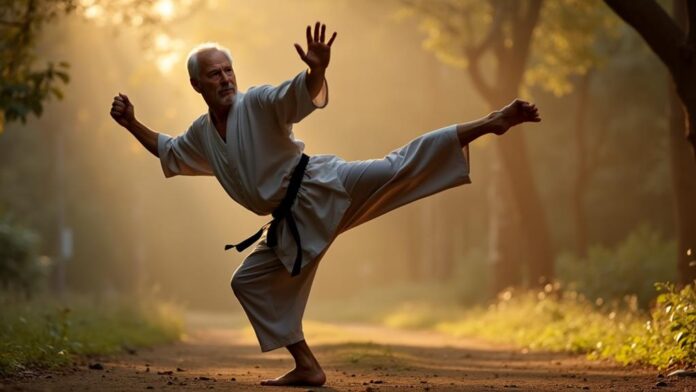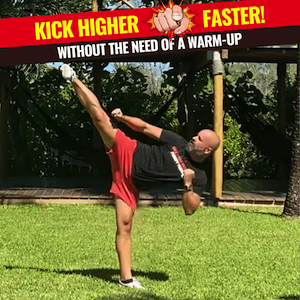As an older martial artist, you need to focus on exercises that improve your strength, flexibility, and cardiovascular fitness while minimizing the risk of injury. You should incorporate compound movements like squats and deadlifts into your training routine to build foundational strength. Complement this with dynamic stretching routines, such as leg swings and arm circles, to enhance flexibility. Low-impact cardiovascular exercises like swimming, cycling, or brisk walking also help. Single-leg stands and tai chi improve balance and reduce injury risk. By incorporating these exercises, you'll be well on your way to improving your overall martial arts performance – and that's just the beginning.
Building Foundational Strength
With age, your body naturally loses muscle mass and joint stability, making it more challenging to maintain mobility and perform martial arts techniques effectively.
That's why building foundational strength is vital for older martial artists like you. By incorporating strength training into your routine, you'll not only enhance your overall performance but also reduce the risk of injury during training and competition.
To build foundational strength, focus on compound movements like squats and deadlifts, which improve muscle mass and joint stability.
When performing resistance training, prioritize proper form and gradual weight increases to prevent injuries and promote muscle engagement.
It's also important to incorporate mobility drills, such as dynamic stretching and yoga, to guarantee a full range of motion and prevent stiffness.
Regular strength training won't only support joint health and mobility but also boost your metabolic rate, aiding in weight management.
By committing to a well-structured strength training program, you'll be able to maintain your mobility, perform techniques with confidence, and enjoy a healthier, more active lifestyle.
Make strength training a priority to take your martial arts training to the next level.
Enhancing Flexibility and Balance
As you build foundational strength, you'll want to complement it with enhanced flexibility and balance to take your martial arts training to the next level. Incorporating dynamic stretching routines, such as leg swings and arm circles, into your conditioning for martial arts will improve your range of motion and overall flexibility. This is essential for older martial artists, as it allows you to execute techniques effectively and reduces your risk of injury.
You'll also benefit from practicing static stretches post-workout, focusing on major muscle groups like your hamstrings, quadriceps, and shoulders. This helps alleviate stiffness and promotes long-term flexibility gains.
To further enhance balance and stability, incorporate exercises like single-leg stands and tai chi movements into your routine. Utilize tools like resistance bands to gradually increase your range of motion while minimizing the risk of strain or injury.
Regular participation in yoga or Pilates won't only improve flexibility but also enhance core strength and balance, contributing to better performance in martial arts and overall physical health. By prioritizing flexibility and balance training, you'll see significant improvements in your martial arts training.
Low-Impact Cardiovascular Training

Your cardiovascular fitness plays an essential role in martial arts training, and low-impact exercises offer an effective way to improve it without putting excessive strain on your joints. As you age, it's vital to maintain a strong cardiovascular system to support your overall health and fitness. Low-impact exercises, such as swimming, cycling, or brisk walking, can help you achieve this goal.
| Exercise | Benefits | Tips |
|---|---|---|
| Swimming | Low-impact, full-body workout | Incorporate interval training to boost cardiovascular fitness |
| Cycling | Easy on joints, improves endurance | Start with short sessions and gradually increase duration |
| Brisk Walking | Improves cardiovascular health, supports weight management | Try incorporating hills or stairs for added challenge |
| Elliptical Training | Reduces impact on knees and hips | Mix up your routine with different resistance levels |
Injury Prevention Strategies
Preventing injuries is a significant aspect of martial arts training, particularly for older athletes who may be more susceptible to chronic damage. As you continue your martial arts journey, it's important to incorporate injury prevention strategies into your training regimen.
One key approach is to adopt a gradual progression, increasing the intensity and duration of your training sessions to allow your body to adapt safely.
To maintain overall fitness and reduce the risk of injury, focus on balanced training that incorporates strength, flexibility, and cardiovascular exercises. Regular stretching is also essential, as it enhances flexibility and range of motion, making it easier to move and perform techniques.
By prioritizing recovery and listening to your body, you can avoid exacerbating potential injuries. This includes recognizing signs of pain or discomfort and adjusting your training accordingly, taking rest and rehabilitation when needed.
Effective Recovery Techniques

Building on the foundation of injury prevention strategies, effective recovery techniques become the next vital component of a well-rounded training regimen for older martial artists.
To optimize your recovery, incorporate regular massage therapy into your routine. This will help reduce muscle tension and improve circulation, both of which are essential for older martial artists who require more rest and healing time.
After intense training sessions, use ice therapy to minimize inflammation and accelerate the healing process. Additionally, make stretching routines a post-workout staple to alleviate stiffness and improve flexibility, important for maintaining mobility as you age.
Adequate hydration and nutrition strategies also support muscle recovery and replenish energy stores, aiding overall recovery effectiveness.
Prioritize sleep, aiming for 7-9 hours of quality rest each night, to allow your body to repair itself.
By implementing these effective recovery techniques, you'll be able to optimize your training outcomes and continue performing at your best.



